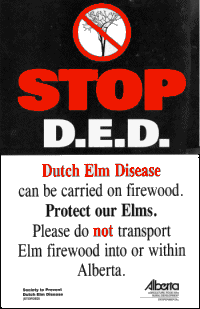| | Back to Dutch Elm Disease Home Page
.
Who and what is STOPDED?
 |

The Society To Prevent Dutch Elm Disease (STOPDED) is a non-profit organization whose mandate is to preserve and protect Alberta's elm trees from Dutch Elm Disease (DED). Members include federal, provincial and municipal representatives, nurserymen, landscapers, commercial and municipal arborists, research scientists, and other interested Albertans. STOPDED members from across the province take an active role in the prevention of DED in Alberta and in their communities. STOPDED has a new hotline number 1-877-837-ELMS.
What is STOPDED doing in Alberta?
STOPDED has an ongoing public awareness campaign focussed on preventing the establishment of DED in Alberta.
In March 1999, STOPDED completed a province wide elm inventory. Location, size and condition information about public and private elms was collected in 529 municipalities. The completed inventory shows that a total of 219,334 elms, valued at $634 million, grow in Alberta's urban areas. The inventory supplies the basic information necessary for an effective management program should DED appear in a municipality. The information also identifies areas where intensive surveillance is necessary due to the number and/or condition of the elm trees.
Funds generated from membership dues and fund raisers are used to provide educational and promotional materials on DED prevention. STOPDED depends on your support and participation in their ongoing prevention program.
What is STOPDED doing in Alberta / Why should we worry about our Elm trees?
Elm tree populations in Alberta are subject to numerous stresses. The most serious threat comes from DED, a fatal fungal disease that infects only elm trees. DED moves rapidly from infected to weakened trees on the bodies of European or native elm bark beetles. The disease can kill an individual tree in as little as three weeks. The whole population of elms in a community can easily be destroyed within a decade.
Currently, Alberta is one of the last two locations in North America that is free of DED. However in 1998, one elm tree in Wainwright was confirmed to have the disease. The tree was immediately removed and burned. This tree was noticed to have typical DED symptoms by STOPDED employees while completing the province-wide elm inventory survey.
Since 1994, the European elm bark beetle have been found throughout the province.
Why do we need to maintain our trees?
- Trees add beauty and give character to communities.
- Trees reduce heating and cooling costs.
- Trees protect us from dangerous ultraviolet radiation.
- Trees prevent both wind and water erosion.
- Trees convert carbon dioxide into oxygen.
- Trees increase the value of real estate.
- Trees reduce noise, dust and air pollution.
What can you do to help save our Elms?
- Take preventive measures by keeping your elm trees healthy, vigorous and properly pruned.
- Elms should be well watered from April to mid August. To allow the trees to harden off for the winter, watering should be stopped mid August, followed by a good soaking or two before freeze-up.
- Dead and dying elm branches and trees provide an ideal breeding site for the elm bark beetles that spread DED and must be removed. Beetles are attracted to fresh tree wounds, therefore pruning must be done between October 1 and March 31 when beetles are not active.
- Dispose of all elm wood by burning or burying it.
- Learn how to identify the signs of DED and beetle activity. As early as June, the leaves on a DED-infected elm will wilt, turn yellow, then curl and turn brown. This is accompanied by brown staining in the sapwood under the bark.
- Become an active STOPDED member.
Do Not!
- Do Not store elm firewood! It is illegal!
- Do Not transport elm firewood into or within Alberta!
- Do Not prune elms between April 1st and September 30th. The beetles are active during this time, they will
be attracted to the scent of fresh tree cuts, possibly infecting a healthy tree.

For information about STOPDED or Dutch elm disease contact stopded@shaw.ca at STOPDED Hotline: 1-877-837-ELMS (3567)
|
|